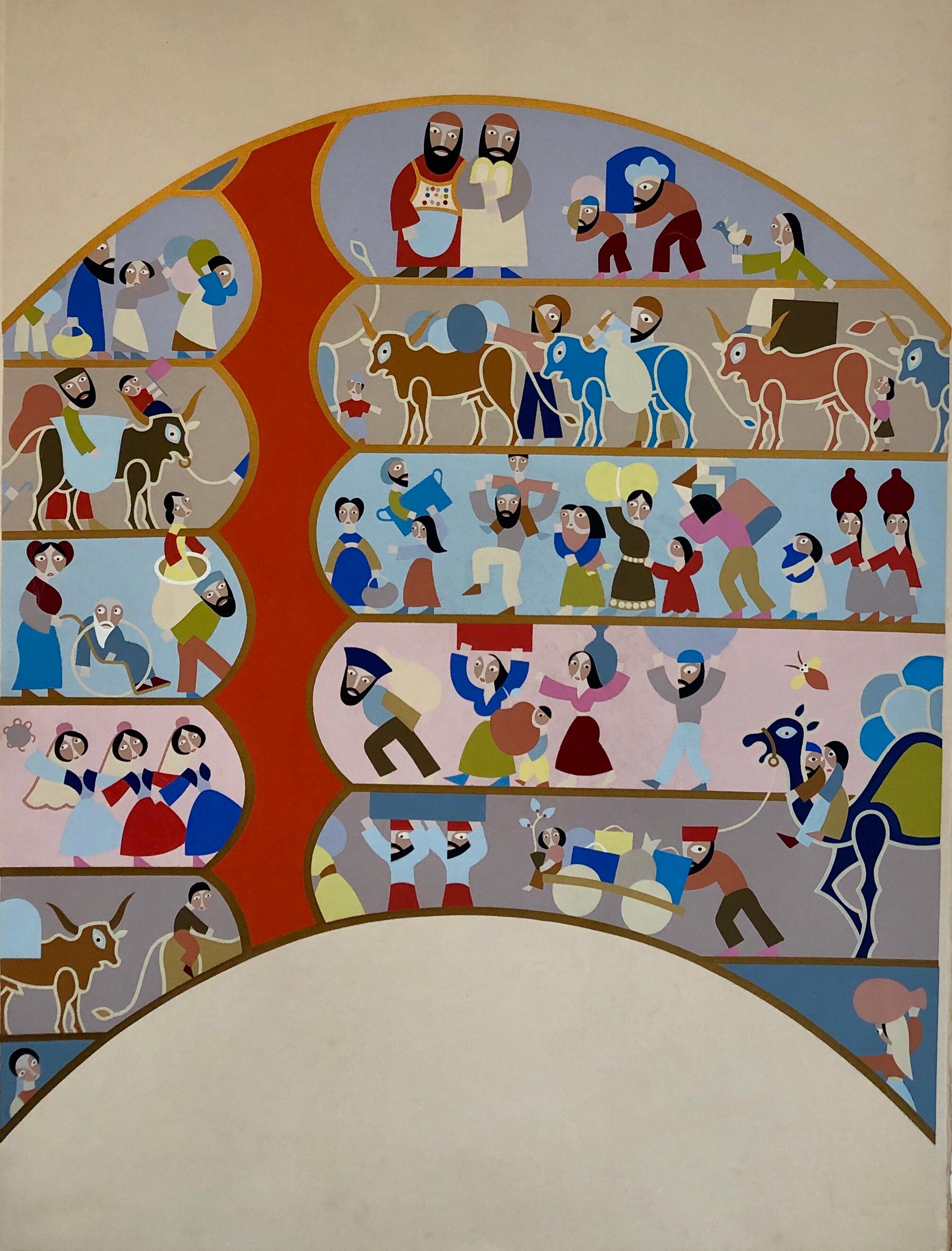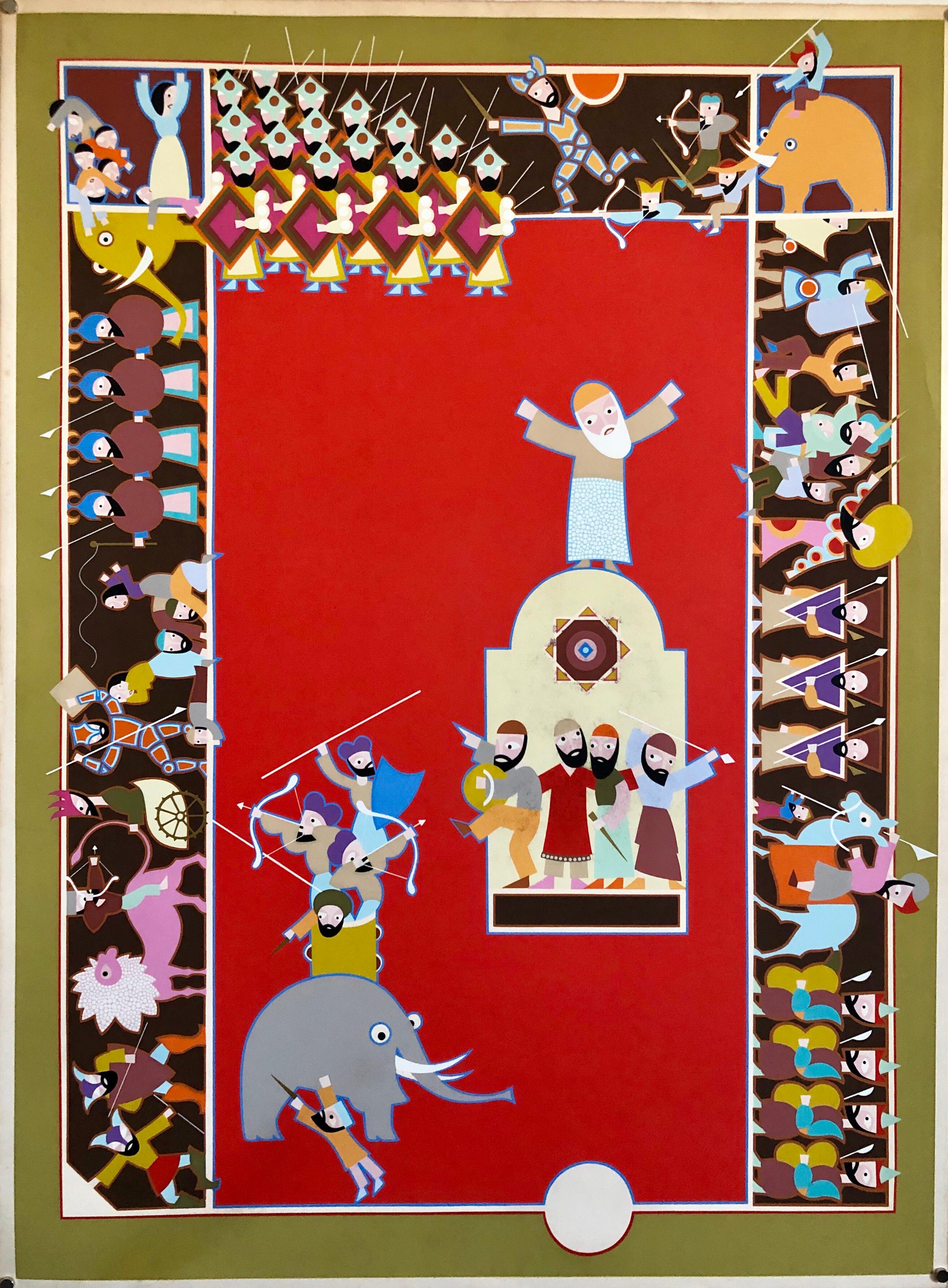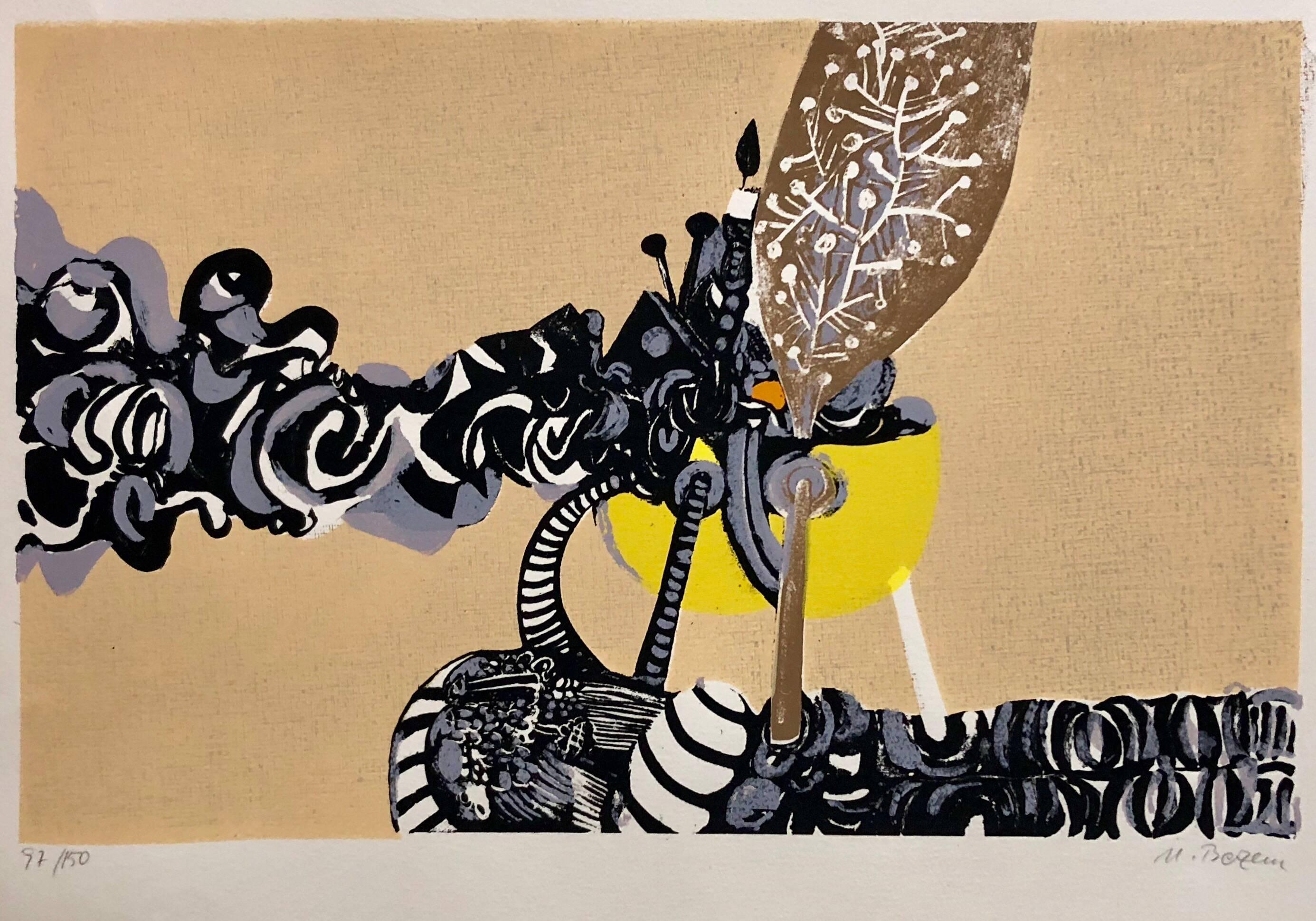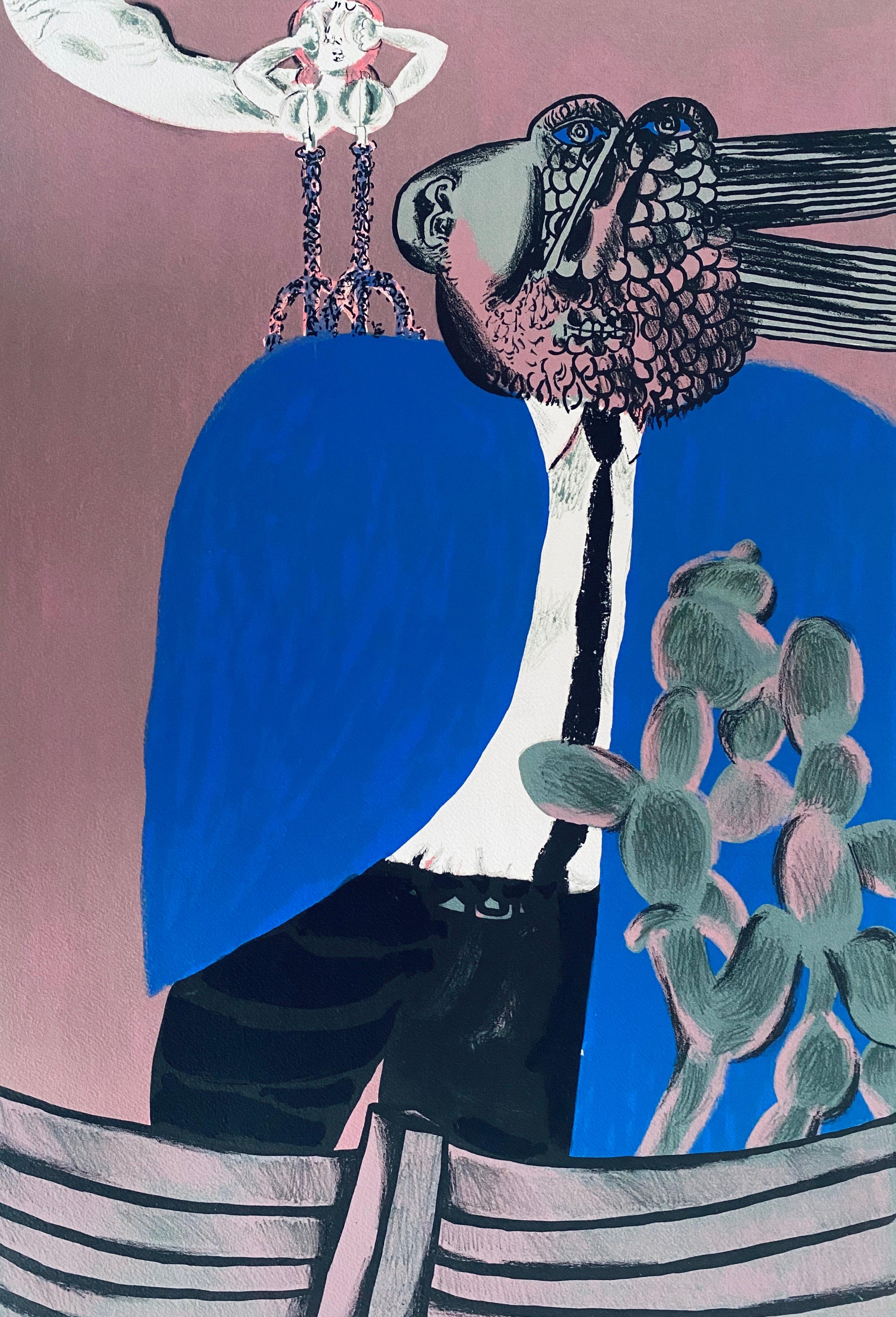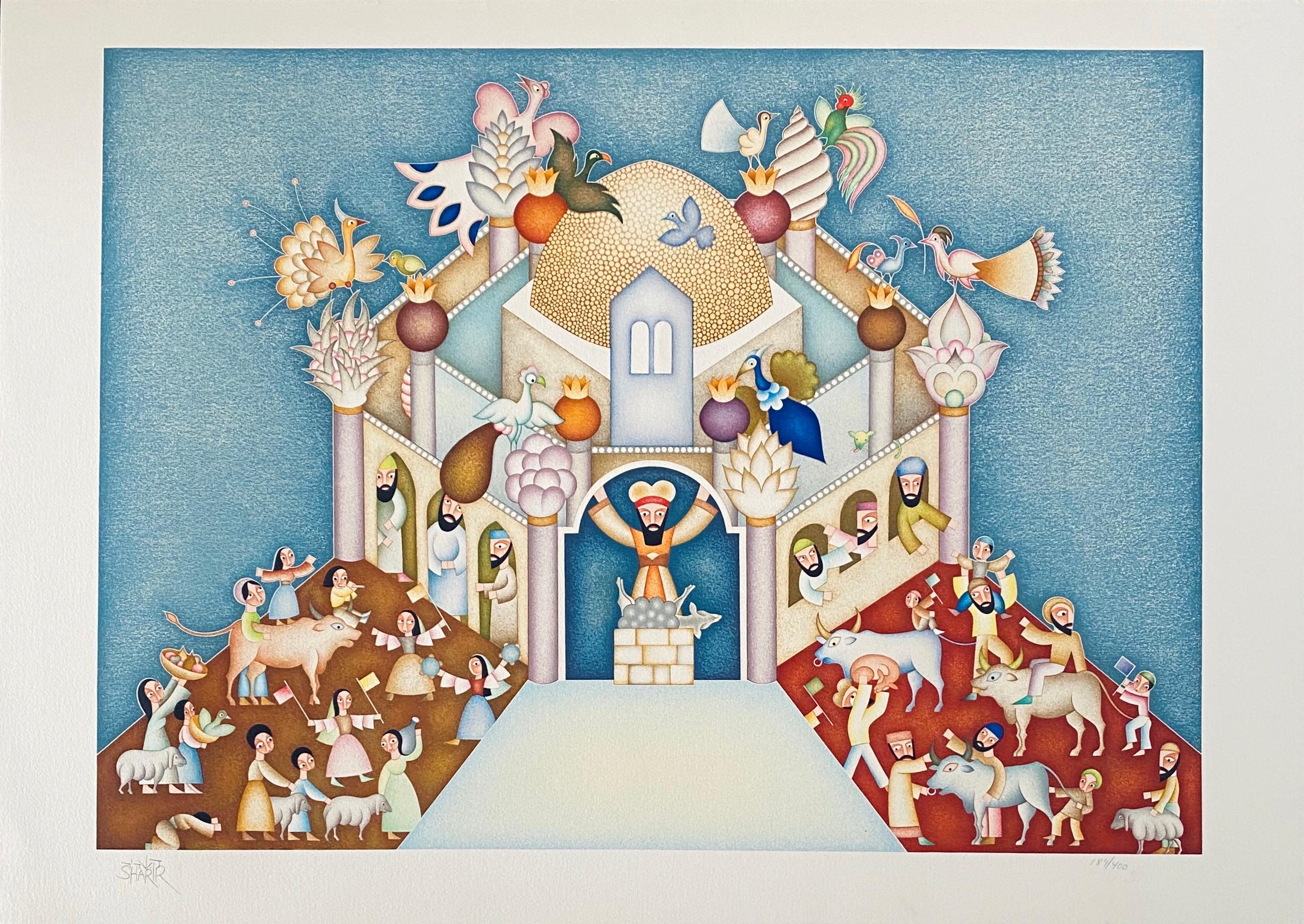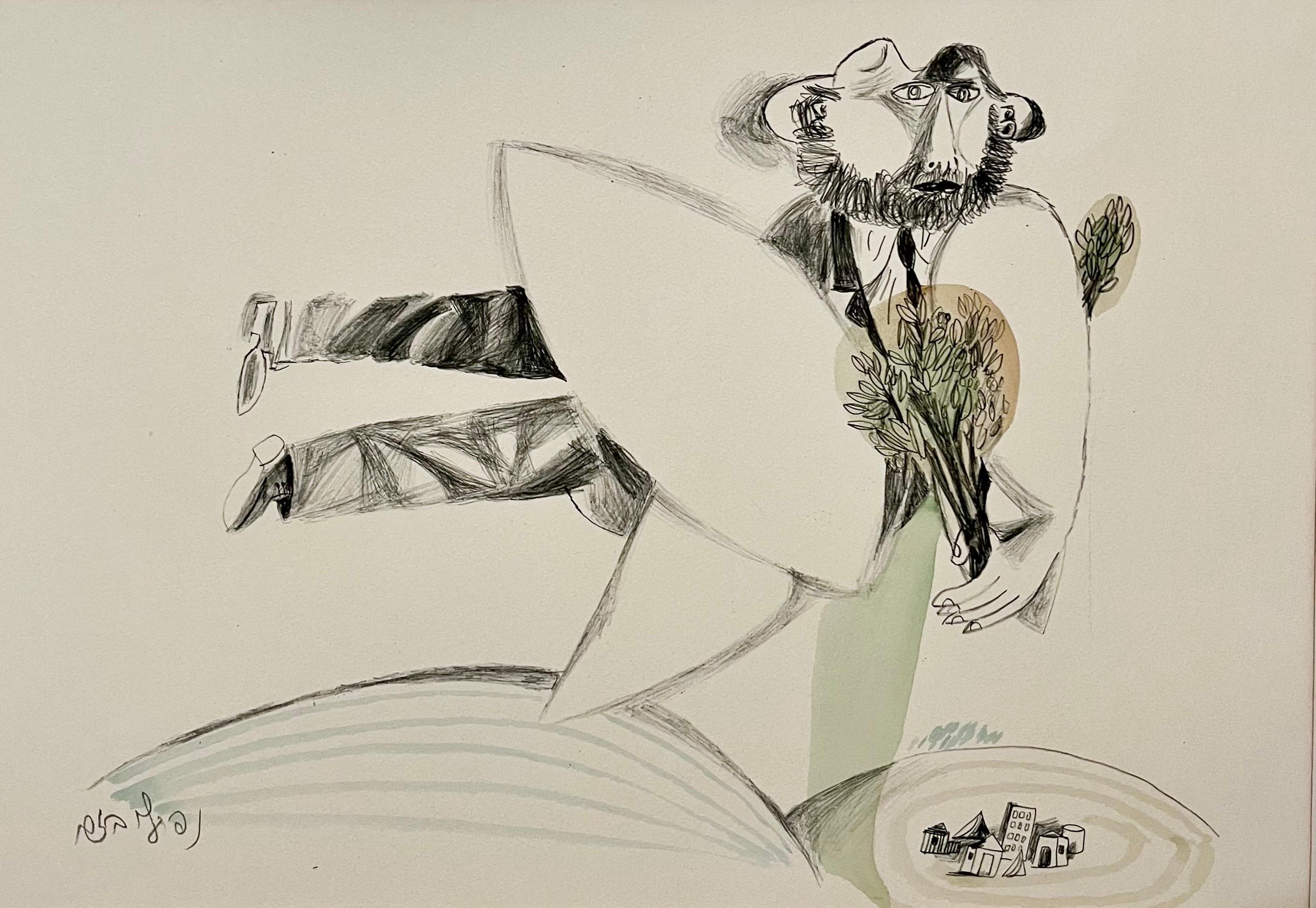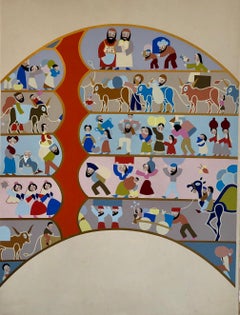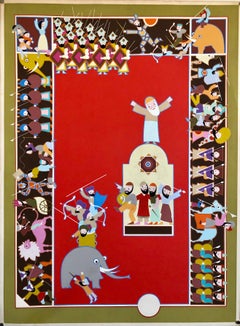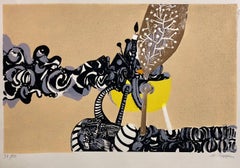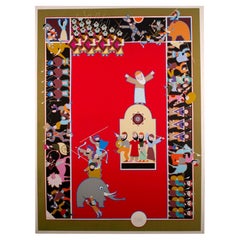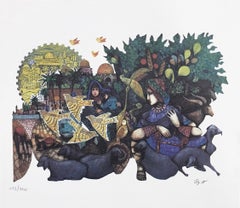Items Similar to Israeli Modern Tu BiShvat Lithograph Silkscreen David Sharir Holiday Serigraph
Want more images or videos?
Request additional images or videos from the seller
1 of 9
David SharirIsraeli Modern Tu BiShvat Lithograph Silkscreen David Sharir Holiday Serigraphc.1980
c.1980
$1,200
£935.03
€1,060.77
CA$1,724.67
A$1,899.03
CHF 984.73
MX$22,489.71
NOK 12,500.50
SEK 11,683.14
DKK 7,922.67
About the Item
This is a mixed lithograph and serigraph silkscreen as per descriptions i read. this is not signed or numbered. it is a rare artists or printers proof print.
David Sharir was born in 1938 in Tel Aviv, Israel and currently resides there.
David Sharir, the son of Russian immigrants, was born in Israel. Beginning his study of art in Tel Aviv and continuing in Florence and Rome, where he studied architecture and theater design. The brightly colored costumes and intricate stage designs he created for these productions have profoundly influenced his art. When Sharir moved to Jaffa in 1966, his hallmark style was truly developed. Studio, family, and spiritual devotion all serve as inspiration for the imagery in his work. His evolving style combines personal experience, Biblical symbolism, and fantasy.
David Sharir, born 1938, Tel Aviv. Was among the first artists to settle in Old Jaffa in 1966. He depicted biblical subjects with a touch of humour and designed sets and costumes for the theatre and opera.
Graphic Art in Israel Today Tel Aviv Museum, Tel Aviv 1973
Israel 1948-1958: Watercolors, Drawings, Graphics
The Bezalel National Museum, Jerusalem 1958
Jean David, Yosl Bergner, Menachem Shemi, Zvi Mairovich, Ruth Schloss, Nahum Gutman, Moshe Elazar Castel, Marcel Janco, Abel Pann, Amos Yaskil, Mordechai Levanon, Reuven Rubin, Maryan, Pinchas Litvinovsky, Ludwig Blum.
Education Avni Institute, Tel Aviv.
Advanced studies with Aharon Kahana, Yohanan Simon and Israel Paldi.
1959-1961 Florence, Fine Arts Academy.
1964-1961 University of Rome, Architecture.
- Creator:David Sharir (1938, Israeli)
- Creation Year:c.1980
- Dimensions:Height: 29.5 in (74.93 cm)Width: 22.5 in (57.15 cm)
- Medium:
- Movement & Style:
- Period:
- Condition:minor wear, minor staining/toning, see photos.
- Gallery Location:Surfside, FL
- Reference Number:1stDibs: LU38213915812
David Sharir
David Sharir: A leading contemporary Israeli artist, David Sharir first studied art in Tel Aviv. He then became a student at the Academia del Bella Arte, Florence, Italy, and studied both architecture and theatre design at the University of Rome. Upon his return to Israel, David Sharir first gained fame for his many great theatre designs. His first one man exhibitions of art took place in Tel Aviv (1959) and Rome (1961). Since that time his art has been frequently exhibited in Israel, Italy, Germany, France and the United States. David Sharir's original prints and paintings are now included in such major collections as the Tel Aviv Museum, Israel, the Israel Museum, Jerusalem, the Philadelphia Museum of Art and the Los Angeles County Museum. The art of David Sharir draws upon many elements. He has found inspiration from such forms of art as the calligraphy of Torah scribes, medieval Hebrew manuscripts, the paintings of Italian primitives and the work of Russian folk art to create his own both beautiful and highly decorative style.
About the Seller
4.9
Platinum Seller
Premium sellers with a 4.7+ rating and 24-hour response times
Established in 1995
1stDibs seller since 2014
1,836 sales on 1stDibs
Typical response time: 1 hour
- ShippingRetrieving quote...Shipping from: Surfside, FL
- Return Policy
More From This Seller
View AllIsraeli Modern Passover Lithograph Silkscreen David Sharir Holiday Art Serigraph
By David Sharir
Located in Surfside, FL
This is a mixed lithograph and serigraph silkscreen as per descriptions i read. this is not signed or numbered. it is a rare artists or printers proof print. It depicts Moses and Aaron at the top and I believe it relates to Passover and the exodus from Egypt.
David Sharir was born in 1938 in Tel Aviv, Israel and currently resides there.
David Sharir, the son of Russian immigrants, was born in Israel. Beginning his study of art in Tel Aviv and continuing in Florence and Rome, where he studied architecture and theater design. The brightly colored costumes and intricate stage designs he created for these productions have profoundly influenced his art. When Sharir moved to Jaffa in 1966, his hallmark style was truly developed. Studio, family, and spiritual devotion all serve as inspiration for the imagery in his work. His evolving style combines personal experience, Biblical symbolism, and fantasy.
David Sharir, born 1938, Tel Aviv. Was among the first artists to settle in Old Jaffa in 1966. He depicted biblical subjects with a touch of humour and designed sets and costumes for the theatre and opera.
Graphic Art in Israel Today Tel Aviv Museum, Tel Aviv 1973
Israel 1948-1958: Watercolors, Drawings, Graphics
The Bezalel National Museum, Jerusalem 1958
Jean David, Yosl Bergner, Menachem Shemi, Zvi Mairovich, Ruth Schloss, Nahum Gutman, Moshe Elazar Castel...
Category
20th Century Contemporary Figurative Prints
Materials
Lithograph
Israeli Modern Hanukkah Lithograph Silkscreen David Sharir Holiday Serigraph Art
By David Sharir
Located in Surfside, FL
This is a mixed lithograph and serigraph silkscreen as per descriptions i read. this is not signed or numbered and is marked sample. it is a rare artists or printers proof print.
David Sharir was born in 1938 in Tel Aviv, Israel and currently resides there.
David Sharir, the son of Russian immigrants, was born in Israel. Beginning his study of art in Tel Aviv and continuing in Florence and Rome, where he studied architecture and theater design. The brightly colored costumes and intricate stage designs he created for these productions have profoundly influenced his art. When Sharir moved to Jaffa in 1966, his hallmark style was truly developed. Studio, family, and spiritual devotion all serve as inspiration for the imagery in his work. His evolving style combines personal experience, Biblical symbolism, and fantasy.
David Sharir, born 1938, Tel Aviv. Was among the first artists to settle in Old Jaffa in 1966. He depicted biblical subjects with a touch of humour and designed sets and costumes for the theatre and opera.
Graphic Art in Israel Today Tel Aviv Museum, Tel Aviv 1973
Israel 1948-1958: Watercolors, Drawings, Graphics
The Bezalel National Museum, Jerusalem 1958
Jean David, Yosl Bergner, Menachem Shemi, Zvi Mairovich, Ruth Schloss, Nahum Gutman, Moshe Elazar Castel...
Category
20th Century Contemporary Figurative Prints
Materials
Lithograph
Rare Israeli Surrealist Judaica Abstract Lithograph Naftali Bezem
By Naftali Bezem
Located in Surfside, FL
Fine lithograph on deckle edged French Arches paper. Pencil signed and numbered from edition of 150.
A Surrealist Judaica scene of a bearded man (Rabbi) in a boat with Shabbat candlesticks. with blindstamp from Editions Empreinte in Paris, France. (They published, Jean Michel Folon, Sempe, Raoul Ubac, Raymond Savignac, Cesar, Bengt Lindstrom , Paul Aizpiri and many other modern masters.
Naftali Bezem (Hebrew: נפתלי בזם; born November 27, 1924) is an Israeli painter, muralist, and sculptor.
Bezem was born in Essen, Germany, in 1924. His early adolescence was spent under Nazi oppression, in constant fear for the safety of his parents, who perished in the Holocaust in the Polish Auschwitz concentration camp. Naftali emigrated to Mandate Palestine in 1939, at the age of fourteen with a Youth Aliyah group.
From 1943 to 1946, he studied art at the Bezalel Academy of Art and Design in Jerusalem with Israeli painter Mordecai Ardon. He then spent three years studying in Paris.His most famous public works include a wall relief at Yad Vashem in Jerusalem and the ceiling mural in the main reception room at the President's Residence, Jerusalem.In 1957, Bezem was a co-recipient of the Dizengoff Prize for Painting.
Group Exhibitions
Orit Art Gallery, Tel Aviv
Artists: Yosef Zaritsky, Marcel Janco, Lea Nikel, Robert Baser, Bezem, Michael Druks,
Israeli Painting (Watercolors and Gouache)
Artists:
Pinchas Abramovich, Bezem, Naftali Nachum Gutman, Haim Gliksberg, Mordechai Levanon, Avigdor Stematsky, Avshalom Okashi, Yehiel Krize...
Category
20th Century Modern Figurative Prints
Materials
Lithograph
Israeli Surrealist Judaica Abstract Lithograph Naftali Bezem
By Naftali Bezem
Located in Surfside, FL
Naftali Bezem (Hebrew: נפתלי בזם; born November 27, 1924) is an Israeli painter, muralist, and sculptor.
Bezem was born in Essen, Germany, in 1924. His early adolescence was spent...
Category
20th Century Modern Prints and Multiples
Materials
Lithograph
Israeli Naive Folk Art Silkscreen Lithograph David Sharir - Bet Hamikdash Scene
By David Sharir
Located in Surfside, FL
David Sharir was born in 1938 in Tel Aviv, Israel and currently resides there.
David Sharir, the son of Russian immigrants, was born in Israel. Beginning his study of art in Tel Aviv...
Category
20th Century Folk Art Figurative Prints
Materials
Screen
Rare Israeli Modernist Judaica Watercolor Painting on Lithograph Naftali Bezem
By Naftali Bezem
Located in Surfside, FL
Naftali Bezem (Hebrew: נפתלי בזם; born November 27, 1924) is an Israeli painter, muralist, and sculptor.
Bezem was born in Essen, Germany, in 1924. His early adolescence was spent ...
Category
20th Century Modern Figurative Drawings and Watercolors
Materials
Watercolor, Lithograph
You May Also Like
"Rosh Hashana" From the suite "The Seven Festivals"
By David Sharir
Located in San Francisco, CA
This artwork titled "Rosh Hashana" from the suite "The Seven Festivals" 1981, is an original colors serigraph on Arches paper by noted Israeli artist David Sharir,b. 1938. It is hand...
Category
Late 20th Century Modern Figurative Prints
Materials
Screen
"Tu B'Shvat'" From the suite "The Seven Festivals"
By David Sharir
Located in San Francisco, CA
This artwork titled "Tu B'Shvat" from the suite "The Seven Festivals" 1981, is an original colors serigraph on Arches paper by noted Israeli artist David Sharir,b. 1938. It is hand s...
Category
Late 20th Century Modern Figurative Prints
Materials
Screen
David Sharir Hannukah Signed Modern Judaica Serigraph on Paper 104/225 Unframed
Located in Keego Harbor, MI
A modern Judaica serigraph on paper titled "Hannukah" by Israeli artist David Sharir. Hand signed in pencil mid bottom with an annotation of 104/225. Sh...
Category
Late 20th Century Prints
Materials
Paper
DAVID THE SHEPARD (JUDAICA ART)
By Amram Ebgi
Located in Aventura, FL
Lithograph in colors on paper. Hand signed and numbered by the artist. From the edition of 200.
Artwork is in excellent condition. Certificate of authenticity included. All reason...
Category
Late 20th Century Contemporary Figurative Prints
Materials
Paper, Lithograph
$100 Sale Price
50% Off
TAFILAH AT THE WALL (JUDAICA ART)
By Amram Ebgi
Located in Aventura, FL
Embossed lithograph with foil stamping on paper. Hand signed and numbered by the artist. From the edition of 450.
Artwork is in excellent condition. Certificate of authenticity inc...
Category
Late 20th Century Contemporary Figurative Prints
Materials
Foil
$100 Sale Price
50% Off
Shavuoth
By David Sharir
Located in San Francisco, CA
This artwork titled "Shavuoth" from the suite "The Seven Festivals" 1981, is an original colors serigraph on Arches paper by noted Israeli artist David Sharir,b. 1938. It is hand sig...
Category
Late 20th Century Modern Figurative Prints
Materials
Screen
More Ways To Browse
New Orleans Lithograph
Oscar Howe
Pablo Picasso 1965
Pablo Picasso Danseurs
Paintings Of Pastries
Patriotic Vintage Americana
Peanuts Characters
Peter Doig Signed Prints
Peter Max 1981
Peter Max Rainbow
Pettibon Poster
Picasso Lithograph Ballet
Picasso Lithographs 1964
Picasso Numbered Print
Picasso Plage
Picasso Tree
Pierre Brissaud
Portrait Self Collage
